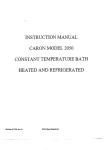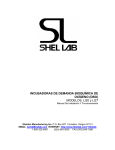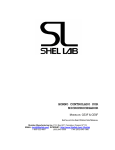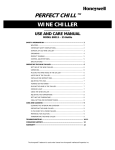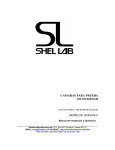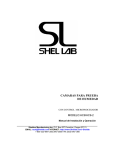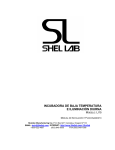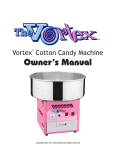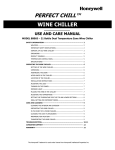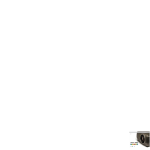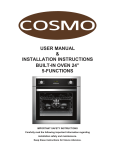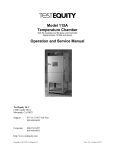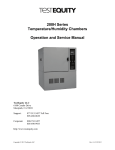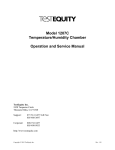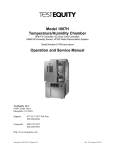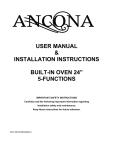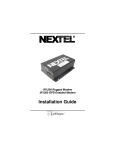Download TestEquity FS Series Forced Air Ovens
Transcript
FS Series Forced Air Ovens Operation and Service Manual TestEquity LLC 6100 Condor Drive Moorpark, CA 93021 Support: 877-512-3457 Toll Free 805-480-0638 Corporate: 800-732-3457 805-498-9933 http://www.testequity.com Copyright © 2003-2012 TestEquity LLC Rev. 1.32, 06-13-2012 Table of Contents Chapter 1 – Safety Instructions ________________________________________________ 1-1 Introduction ____________________________________________________________________ 1-1 Safety Notices ___________________________________________________________________ 1-1 Chapter 2 – Receiving and Installation__________________________________________ 2-1 Inspection ______________________________________________________________________ 2-1 Return Shipment ________________________________________________________________ 2-1 Installation______________________________________________________________________ 2-1 Power Requirements ____________________________________________________________________ 2-2 Location _____________________________________________________________________________ 2-2 Lifting / Handling ______________________________________________________________________ 2-2 Leveling _____________________________________________________________________________ 2-2 Initial Burn-In _________________________________________________________________________ 2-2 Initial Cleaning ________________________________________________________________________ 2-2 Chapter 3 – Operation _______________________________________________________ 3-1 Front Panel Controls _____________________________________________________________ 3-1 Power Switch _________________________________________________________________________ 3-1 Timer Switch __________________________________________________________________________ 3-1 Overtemperature Protection Thermostat _____________________________________________________ 3-1 Overtemperature Light __________________________________________________________________ 3-1 Timer ________________________________________________________________________________ 3-1 Temperature Controller __________________________________________________________________ 3-1 Heating Light _________________________________________________________________________ 3-1 Operating the Oven ______________________________________________________________ 3-2 Turning the Oven On ___________________________________________________________________ 3-2 Setting the Temperature Controller _________________________________________________________ 3-2 Setting the Overtemp Protection Thermostat _________________________________________________ 3-2 Setting the Timer _______________________________________________________________________ 3-3 Chapter 4 – Maintenance _____________________________________________________ 4-1 Cleaning ________________________________________________________________________ 4-1 Storage _________________________________________________________________________ 4-1 Calibration _____________________________________________________________________ 4-1 Troubleshooting Guide ___________________________________________________________ 4-2 Parts List _______________________________________________________________________ 4-5 Specifications____________________________________________________________________ 4-5 Wiring Diagram _________________________________________________________________ 4-6 Chapter 5 - Warranty ________________________________________________________ 5-1 Chapter 1 – Safety Chapter 1 – Safety Instructions Introduction Follow all CAUTION notices to prevent damage to the chamber or your test sample. Failure to follow all CAUTION notices may void your warranty. CAUTION may also indicate a potentially hazardous situation which, if not avoided, may result in minor or moderate personal injury. WARNING indicates a potentially hazardous situation which, if not avoided, could result in death or serious injury. The safety alert symbol ! precedes a general CAUTION or WARNING statement. The electrical hazard symbol 2 precedes an electric shock hazard CAUTION or WARNING statement. Safety Notices ! WARNING: These units are general purpose air ovens for professional, industrial or educational use where the preparation or testing of materials is done at approximately atmospheric pressure and no flammable, volatile or combustible materials are being heated. These units are not intended for hazardous or household locations or use. ! WARNING: THIS OVEN IS NOT DESIGNED TO HANDLE COMBUSTIBLE GASSES AND IS NOT AN EXPLOSION PROOF UNIT. Do not place explosive, combustible, or flammable materials into the chamber. ! WARNING: Some outgassed byproducts may be hazardous or unpleasant to operating personnel. If this is the case, the oven exhaust should be positively ventilated to the outside according to local regulations. A power exhaust is optionally available which greatly helps under these applications. ! WARNING: Do not operate near noxious fumes. ! CAUTION: Do not place sealed or filled containers in the oven chamber. ! CAUTION: If a mercury thermometer is used for calibration and breakage should occur, all spilled mercury MUST be completely removed from the chamber before continuing operation. ! CAUTION: Be sure that the power supply is of the same voltage as specified. 2 WARNING: Do not cut or remove the ground prong from the power cord. Do not use a 2prong adapter plug. TestEquity FS Series Ovens Page 1-1 Chapter 1 – Safety 2 WARNING: Disconnect the unit from its electrical source before proceeding to make any electrical repairs or replacements. ! CAUTION: This oven is NOT designed for the use in Class I, II, or III locations as defined by the National Electric Code. 2 WARNING: This oven is not intended, nor can it be used, as a patient connected device. Page 1-2 TestEquity FS Series Ovens Chapter 2 – Receiving and Installation Chapter 2 – Receiving and Installation Your satisfaction and safety require a complete understanding of this unit. Read the instructions thoroughly and be sure that all users are given adequate training before attempting to use this unit. Note: This equipment must be used only for its intended purpose; any alterations or modifications will void your warranty. Inspection The carrier, when accepting shipment, also accepts responsibility for safe delivery and is liable for loss or damage claims. On delivery inspect for visible exterior damage, note and describe on the freight bill any damage found and enter your claim on the form supplied by the carrier. Inspect for concealed loss or damage on the unit itself, both interior and exterior. If any, the carrier will arrange for official inspection to substantiate your claim. Verify that your accessory package is complete. All units should have a set of four (4) Leveling feet, two (2) shelves and eight (8) shelf clips. Return Shipment Save the shipping crate and all packaging material until you are sure the oven has not been damaged and is functioning correctly. If for any reason you must return the unit, contact your customer support representative for authorization and supply data plate information. Make sure to include the model and serial number. The service representatives will furnish you with a return authorization number and address for return. Note: Make sure this return authorization number appears on the unit packaging and shipping papers. Units returned without proper authorization may not be accepted at the factory. For information on where to contact customer support please see the manual cover. Installation Local city, county or other ordinances may govern the use of this equipment. If you have any questions about local requirements, please contact the appropriate local agency. Installation may be performed by the end user. This unit is intended for use indoors, at room temperatures between 5° to 40°C (41° to 104°F), at no greater than 80% Relative Humidity (at 25°C/77°F) and with a supply voltage that does not vary by more than ±10%. Customer support should be contacted for operating conditions outside these limits. TestEquity FS Series Ovens Page 2-1 Chapter 2 – Receiving and Installation Power Requirements The power requirements are listed on the oven’s data plate located on the rear. Make sure your power supply matches that shown on the data plate. VOLTAGE SHOULD NOT VARY MORE THAN ±10% FROM THE DATAPLATE RATING. These units are intended for 50/60 Hz application. A separate circuit is recommended to preclude loss of product due to overloading or circuit failure. Location Select a site for the oven which is free from extreme heat, cold or excessive air movement such as areas near steam radiators, stoves, other ovens, autoclaves, direct sun, heating and cooling ducts, etc. Avoid high traffic areas which may reduce the accessibility to the oven. Allow at least 2 inches of space between the oven and surrounding walls or partitions which might prevent free airflow. Lifting / Handling These ovens are heavy and care should be taken to use appropriate lifting devices that are sufficiently rated for these loads. Ovens should only be lifted from their bottom surfaces. Doors, handles and knobs are not adequate lifting or stabilization. The oven should be completely restrained from tipping during lifting or transport. All moving parts, such as shelves and trays should be removed and doors need to be positively locked in the closed position during transfer to prevent shifting and damage. Leveling The oven must sit level and solidly. Leveling feet (supplied) are to be installed in the holes at the base of the oven. Turn them counterclockwise to raise the level and clockwise to lower the level. If the oven must be transported, turn the leveling feet in all the way to prevent damage. Initial Burn-In It is recommended that the unit go through a “burn-in” process prior to operation. This is to eliminate the smoking of protective coatings on the element. Read the operating instructions carefully to understand the operating requirements. To burn-in, turn the OVERTEMP PROTECTION to maximum and set the TEMPERATURE controller to 200°C. Open the exhaust vent damper on the top of the oven. Run for a minimum of one hour under ventilation until smoke dissipates. Initial Cleaning The oven’s interior was cleaned at the factory. If you need to clean it further, use a cleaner that is suitable for your application. Make sure to rinse the cleaned surface with a damp cloth, using water only, and dry the surfaces with a clean cloth. DO NOT USE chlorine-based bleaches or abrasives as they will damage the stainless steel surface. DO NOT USE spray cleaners that might leak through openings and cracks and get on electrical parts or that may contain solvents that will harm the coatings. A similar periodic cleaning is recommended. ! WARNING: Never clean the unit with alcohol or flammable cleaners with the unit connected to the electrical supply. Always disconnect the unit form the electrical service when cleaning and assure all volatile or flammable cleaners are evaporated and dry before reattaching the unit to the power supply. Page 2-2 TestEquity FS Series Ovens Chapter 3 – Operation Chapter 3 – Operation Front Panel Controls l 0 A l 0 B C D E F G Power Switch (A) The POWER switch controls all power to the oven. It must be in the I (ON) position before any systems are operational. The green light in the switch will be lit when the switch is ON. Timer Switch (B) The TIMER switch controls power to the timer circuit. In the O (OFF) position, the oven heat is controlled with no timed duration. In the I (ON) position, heat is controlled for a timed interval and then the heat shuts off at the end of that interval. Overtemperature Protection Thermostat (C) The OVERTEMP PROTECTION thermostat is an independent controller to protect against any failure which would allow temperature to rise past the TEMPERATURE controller’s set point. The adjustment knob points to a relative scale from 0 to 10. Overtemperature Light (D) The OVERTEMPERATURE pilot lamp is directly below the OVERTEMP PROTECTION thermostat. The light will come on when the OVERTEMP PROTECTION is activated and has taken control of the oven. This pilot lamp should never be on under normal operating conditions. Timer (E) The TIMER consists of a digital display, UP/DOWN arrow pads, a RESET pad, a START/STOP pad and a TIMER ACTIVE light. The TIMER provides the ability to have the oven maintain heat for a specified period of time. Temperature Controller (F) The TEMPERATURE controller consists of digital display and UP/DOWN arrow pads for entering the temperature set point and for calibration. Heating Light (G) The HEATING pilot lamp will be lit whenever the heating elements are energized. It will cycle on/off when the oven approaches and stabilizes at the desired temperature set point. TestEquity FS Series Ovens Page 3-1 Chapter 3 – Operation Operating the Oven Assure that the electrical power source is properly configured and rated for the oven and plug the unit cord into the receptacle. Turning the Oven On Push the POWER switch to the I (ON) position. Push the timer switch to the O (OFF) position. The digital temperature display will indicate a temperature value. Turn the OVERTEMP PROTECTION Thermostat to its maximum clockwise position using a coin or flat head screwdriver. Setting the Temperature Controller To enter the desired set point temperature, press either the UP or DOWN arrow pad once on the TEMPERATURE digital display. The display will start to blink from bright to dim. While blinking, the display is showing the temperature set point. You can change the set point by pushing the UP or DOWN arrow pads to raise or lower the value. If the arrow pads are not pushed within five (5) seconds, the display will stop blinking and return to read the chamber temperature. Allow several hours for the temperature to stabilize. Setting the Overtemp Protection Thermostat The OVERTEMP PROTECTION should be initially set to its maximum position when stabilizing the set point temperature. Once the oven is stable at the desired set point, turn the OVERTEMP PROTECTION counterclockwise (using a coin or flat-head screwdriver) until the OVERTEMPERATURE light comes on. Next, turn the OVERTEMP PROTECTION clockwise just until the OVERTEMPERATURE light goes off. Next, turn the OVERTEMP PROTECTION two (2) minor increments on its scale past the point where the light went out. This sets the OVERTEMP PROTECTION at approximately 10°C above the current temperature set point. Page 3-2 TestEquity FS Series Ovens Chapter 3 – Operation Setting the Timer (Optional for timed operation only) Turn the timer switch to the I (ON) position. TIMER display digits will light with no decimals showing. Note that if several seconds elapse with no arrow or reset pad activity during any of the following steps, the TIMER will default to the present displayed setting and it will be necessary to restart all functions over again. The values must be entered in a consecutive manner with no delays between settings or the default will occur. Hour Function: Press and hold the RESET pad until the digits start blinking, and the left most decimal blinks. In this mode, pressing the UP or DOWN arrow pads increases or decreases the whole hour value from 0 to 99. 10 Minute Function: After the desired value for hours is set, push the RESET pad again. The middle decimal will now blink. Pushing the UP or DOWN arrow pads will increase or decrease the 10 Minute function allowing values between 0 and 5 to be set. 1 Minute Function: After the desired 10 Minute value is set, push the RESET pad again. The right most decimal point will blink. Pushing the UP or DOWN arrow pads will increase or decrease the 1 Minute function allowing values between 0 and 9 to be set. Activation: Wait until the timer stops blinking. After all settings are made, push the START/STOP button. The TIMER ACTIVE light will come on and after a brief pause, the oven temperature set point will be active. The oven will now heat up, control at the set point and stop after the timed period has elapsed. Note that when the system is in the timer mode, the heating circuit is de-energized until the START/STOP button is pushed or the TIMER switch is turned OFF. If a time change or correction is necessary and the timer has already been activated, push the START/STOP button to stop the timer, then repeat the above steps. To set the timer so that timed operation will not start until the oven is stable at set point, pre-heat the oven with the TIMER switch OFF until the desired temperature has stabilized. Turn the TIMER switch ON. Push and hold the RESET button until the TIMER display blinks (to be sure that the pre-set timed value is correct). Press the START/STOP button to activate the timer. TIMER Hours Blinking Decimal > TestEquity FS Series Ovens 10 Min. Hour 1 Min. 10 Min. TIMER ACTIVE 1 Min. Page 3-3 Chapter 4 – Maintenance Chapter 4 – Maintenance 2 WARNING: Disconnect the power cord from the power source before performing any service or maintenance on this unit. No maintenance is required on the electrical components. If the unit fails to operate as specified, please see the Troubleshooting Guide, before calling for service. Cleaning Cleaning and decontamination are recommended on a regular basis. To prepare the unit for cleaning, remove all interior parts if assembled, such as shelves and shelf clips. First, clean the oven interior with soap and water, rinse and let dry. To decontaminate use a solution that is appropriate for your application. DO NOT USE chlorine-based bleaches or abrasives as this can damage the stainless steel components. DO NOT USE spray cleaners that might leak through openings and cracks and get on electrical parts or that may contain solvents that will harm the coatings. Use care when cleaning the door gasket to prevent damage which could impair the positive door seal. ! WARNING: Never clean the unit with alcohol or flammable cleaners with the unit connected to the electrical supply. Always disconnect the unit form the electrical service when cleaning and assure all volatile or flammable cleaners are evaporated and dry before reattaching the unit to the power supply. Storage To prepare the unit for storage, remove all shelves and shelf clips and disconnect the power supply. Be certain that the chamber is completely dry and door is positively secured in the closed position. See Lifting / Handling for proper transport procedures. Calibration Controller Accuracy is ±1°C at the calibrated single set point using the procedure below. It is recommended that calibration is verified with the unit is installed in its working environment, and has been stable at set point for several hours. Place a reference temperature measurement device in the oven. Be certain the sensor does not touch any shelving. Allow again for the temperature to stabilize until five (5) consecutive readings at one minute intervals show no temperature change. Compare the reading on the reference thermometer with the front panel digital display. If there is an unacceptable difference, put the display in calibrate mode by pressing the UP and DOWN arrow pads at the same time until the decimal points blink on and off. While blinking, the display can be changed to match the reference thermometer by pushing the UP or DOWN arrow pads to raise or lower the temperature until the display reads the correct value. If no arrow pads are pressed within five (5) seconds the display will revert to displaying the temperature within the chamber. TestEquity FS Series Ovens Page 4-1 Chapter 4 – Maintenance Troubleshooting Guide TEMPERATURE Temperature too high. Display reads “HI” or “400”+. Temperature too low 1. 2. 1. 1. 2. 3. 4. 5. 6. 7. Display reads “LO” 1. 2. 1. Oven will not heat over a temperature that is below set point 2. Unit will not heat up at all 3. 4. 1. 2. 3. Will not maintain set point Display and reference thermometer don’t match Calibrated at one temperature, but not at another Can’t adjust set points or calibration Page 4-2 4. 5. 1. 2. 1. 2. 3. 4. 5. 1. 1. 2. Controller set point is too high. Controller failed on – call Customer Service. Probe is unplugged, is broken or wire to sensor is broken – trace wire from display to probe. OVERTEMP PROTECTION set too low. TEMPERATURE controller set too low. Unit needs time to recover from door opening – wait for display to stop changing. Unit not recovered from power failure or being turned off – ovens will need several hours to warm up and stabilize. Element failure – compare current draw to data plate. Temperature controller failure – call Customer Service. OVERTEMP PROTECTION failure – confirm with front panel lights that safety thermostat is operating correctly. Bad probe or disconnected – call Customer Service. If ambient temperature is lower than range of unit – compare set points and ambient temperature to rated specifications. Confirm that fan is moving and that amperage and voltage match data plate – check for air movement in chamber. Confirm that set point is set high enough – turn OVERTEMP PROTECTION all the way clockwise and see if OVERTEMPERAURE light comes on. Check connections to sensor. Check calibration using a calibrated instrument. Check amperage – amperage should be virtually at maximum rated (data plate) amperage. Do all controller functions work? Is the Safety Thermostat set high enough? For diagnostics, should be fully clockwise with the OTP light never on. Has the fuse/circuit breaker blown? Has timer turned unit off? Assure that set point is at least 10 degrees over ambient. See if ambient is fluctuating; check for adjacent open doors or HVAC duct openings – stabilize ambient conditions. Calibration error – Controller needs re-calibration. Temperature sensor failure – call Customer Service. Controller failure – call Customer Service. Allow at least two hours to stabilize. Verify that reference thermometer is certified. This can be a normal condition when operating temperature varies widely. For maximum accuracy, calibration should be done at or as close to the set point temperature. Turn entire unit off and on to reset. If repeatedly happens, call Customer Service. TestEquity FS Series Ovens Chapter 4 – Maintenance TEMPERATURE (continued) Indicated chamber temperature unstable 1. 2. 3. ±0.1°C variation is normal. Make sure fan is working. Verify movement of air in chamber. Room temperature is radically changing – either door opening or room airflow from heaters or air conditioning. Stabilize the ambient conditions. 4. This may happen if exhaust stack is 100% open or if power exhaust is cycling – adjust stack to at least ¼ closed. 5. Sensor miss-located, damaged or wires may be damaged. Check mounts for control and overtemperature sensors, then trace wires or tubing between sensors and controls. 6. Defective temperature controller. Call Customer Service. 7. OVERTEMP PROTECTION set too low. Be sure that OVERTEMP PROTECTION is set more than 5 degrees over temperature set point; check if OVERTEMPERATURE light is on continuously; turn OVERTEMP PROTECTION knob completely clockwise to see if problem solved then follow operating instructions for correct setting. 8. Electrical noise. Remove nearby sources of RFI including motors, arcing relays or radio transmitters 9. Bad connection on temperature sensor or faulty sensor. Check connectors for continuity and mechanical soundness while watching display for erratic behavior; check sensor and wiring for mechanical damage. 10. Bad connections or faulty solid state relay. Check connectors for mechanical soundness and look for corrosion around terminals or signs of arcing or other visible deterioration. MECHANICAL Motor doesn’t move 1. Motor makes noise 2. 1. 2. Door not sealing TestEquity FS Series Ovens 3. 1. 2. 3. If shaft spins freely: check connections to motor and check voltage to motor. If shaft rubs or is frozen, relieve binding and retest. If noise is from the motor, tap the top of motor shaft with ball peen hammer. If the sound gets worse, tap the other end of the shaft – avoiding touching the blower wheel. If there is no change, call Customer Service. Adjust hinge blocks, chamber latch bracket or twist the door. Confirm that unit has not been damaged and body is not square. Check physical condition of gasket for tears or punctures. Page 4-3 Chapter 4 – Maintenance OTHER HEATING light is on all the time and temperature is running away 1. Controller timer resets on its own 1. Front panel displays are all off 2. 1. 2. 2. Unit or wall fuse/circuit breaker is 1. 2. blown Unit will not turn on Unit is smoking after initial operation 3. 1. 2. 3. 4. 1. Contamination in chamber 1. 2. Contamination on sample 1. 2. 3. Page 4-4 Adjust set point to room temperature. If the unit is still heating, replace the solid state relay. If cannot change any condition on the front panel, call Customer Service. Confirm that power from wall is consistent and within specifications. Timer is defective. Check connections to the temperature display control board and assure that all are tight and in the correct orientation. Check for wire damage. Check wall power source. Compare current draw and compare to specs on data plate. See what other loads are on the wall circuit. Check wall power source. Check fuse/circuit breaker on unit or in wall. See if unit is ON, e.g., fan or heater, and just controller is off. Check all wiring connections, especially around the on/off switch. This is not an uncommon occurrence when first operating new units. Run at high temperature with vent open for one hour or until smoke dissipates. See cleaning procedure. Develop and follow standard operating procedure for specific application; include definition of cleaning technique and maintenance schedule. See “Contamination in chamber”. Reduce air flow in chamber by dampening down exhaust port; be sure to verify adequate temperature uniformity at the reduced air flow. Protect open samples from areas of maximum air current, e.g., inlet air ducts. TestEquity FS Series Ovens Chapter 4 – Maintenance Parts List Description Adjustable Feet Blower Motor Control Knob Cord Set Door Latch Fuse Holder Fuse 16 Amp Heating Element, FS2 Heating Element-FS4 Heating Element FS5 I/O (On/Off) Power Switch Main Control W/Timer, FS Models Overtemperature Safety Thermostat Pilot Lamp, OTP Pilot Light Heating Shelf Clips Shelf FS2 Shelf FS4 Shelf FS5 Solid State Relay Timer Switch Part Number 200129 4880549 4450506 1800529 X1000456 3300501 3300513 9570523 9570537 9570537 100351 1750612 1750615 200020 200021 200116 5130543 5130516 5130522 101168 X1000124 Specifications Inside Volume Inside Dimensions* Outside Dimensions* Shipping Weight Net Weight Temperature Range Uniformity Controller Accuracy Heat up time Recovery * W x D x H (inches) TestEquity FS Series Ovens FS2 FS4 1.55 cu ft 3.3 cu ft 13 x 14 x 14.75 18.25 x 19 x 6.5 21.25 x 23.75 x 33 27 x 25 x 34.75 120 lbs. 185 lbs. 93 lbs. 115 lbs. 10°C above ambient to 250°C ±2°C at 150°C ±1°C at the calibrated single set point 15 minutes to 150°C 2 minutes at 150°C after 30 sec. door opening Page 4-5 Chapter 4 – Maintenance Wiring Diagram Page 4-6 TestEquity FS Series Ovens Chapter 5 - Warranty TestEquity LLC Limited Warranty TestEquity LLC (TestEquity) warrants Environmental Chambers (Equipment) manufactured by TestEquity and supplied under this contract to be free from defects in materials and workmanship under normal use and proper maintenance. TestEquity will repair or replace any defective part for a period of THREE YEARS from the date of invoice. TestEquity reserves the right to require any defective part be returned, freight prepaid, to TestEquity’s factory or to inspect any defective part at the Purchaser’s site. TestEquity shall have sole discretion to determine whether any part is defective and whether any defective part will be repaired or replaced. This limited warranty shall extend to any standard chamber accessory and component part which is normally sold by TestEquity. Non-standard accessories and component parts specified by the Purchaser shall be warranted only to the extent of the original manufacturer’s warranty, if any exists. If the repair or replacement is performed in the FIRST YEAR from the date of invoice, TestEquity will also pay for the labor associated with the repair at the Purchaser’s site, subject to TestEquity’s prior approval. During the SECOND and THIRD YEAR of the warranty period, Purchaser will be responsible for the installation and cost of installation of replacement or repaired parts. Purchaser shall notify TestEquity in writing of any alleged defect within 10 days after its discovery within the warranty period. TestEquity reserves the right to satisfy the labor portion of this limited warranty either through its own service personnel or an authorized agent. In order to provide expeditious service, TestEquity reserves the right to satisfy its limited warranty obligation by sending replacement parts to be installed by the Purchaser if they can be installed easily without special tools or training. TestEquity reserves the right to satisfy this limited warranty by requiring the Purchaser to return the Equipment to TestEquity when such return is feasible. The following parts are excluded from this limited warranty and are sold as-is or are considered expendable: interior light bulb, viewing window, paint and cosmetic surface finishes and treatments, and port plugs. This limited warranty shall extend in full to Equipment installed within continental United States and Canada. For all other locations, Purchaser is responsible for all labor costs for repairs or parts installation, and for all shipping costs associated with providing replacement parts. This limited warranty does not cover: (1) Defects or damages arising as the result of shipment by common carriers or private transportation, unless TestEquity undertakes shipment and transportation of the Equipment to Purchaser’s site or contractually assumes the risk of damage to the Equipment in shipment; (2) Defects or damages arising out of, or as the result, of mishandling, modification, or improper start up, installation or maintenance of the Equipment (including start up, installation or maintenance not in accordance with TestEquity’s written procedures); (3) Defects or damages resulting from, or arising out of, abuse, misuse, neglect, intentional damage, accident, fire, flood, earthquake, or any other act of God. This warranty as to Equipment is LIMITED to repair or replacement of parts or Equipment in the determination of TestEquity Inc. THE FORGOING LIMITED WARRANTY IS IN LIEU OF ALL OTHER WARRANTIES INCLUDING THE IMPLIED WARRANTIES OF FITNESS FOR A PARTICULAR PURPOSE AND MERCHANTABILITY. TestEquity Inc. DISCLAIMS ANY LIABILITY FOR ANY DAMAGES RESULTING FROM DELAY OR LOSS OF USE IN SERVICE OR REPAIR, OR FOR INCIDENTAL OR CONSEQUENTIAL DAMAGES ARISING OUT OF OR IN CONNECTION WITH THE USE OR PERFORMANCE OF THE EQUIPMENT, EXCEPT AS STATED IN THIS PARAGRAPH. This limited warranty cannot be modified in any way except in writing by both TestEquity and Purchaser. Invalidation of any one or more of the provisions of this limited warranty shall in no way affect any of the other provisions hereof, which remain in full force and effect. This limited warranty shall be extended only to the first Purchaser of this Equipment and is not transferable.



















